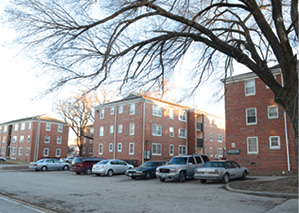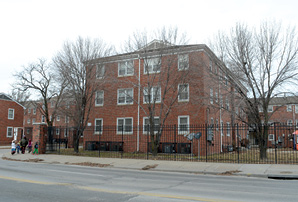
By LESLIE COLLINS
Northeast News
January 22, 2014
East of Kansas City’s downtown sits the Chouteau Courts, the city’s oldest and least liked public housing complex. It is the last desirable pick for public housing residents and has about twice the average resident turnover rate for Kansas City, according to the Paseo Gateway Transformation Plan.
“It’s built on top of an old landfill, so we’ve had some settlement issues, and there’s some sinkholes,” said John Monroe, director of planning and development at the Housing Authority of Kansas City (HAKC). “It’s very isolated; there’s no adjacent residential property and it sits across the street from some very rundown properties. It was built in 1958, and it’s just not up to standards.”
In addition to outdated floor plans, the apartments suffer from structural issues and are too compact, according to the Transformation Plan. The average size of a three bedroom apartment totals 850 square feet, compared to area market rate units of 1,200 square feet.
“This is one of the last public housing developments that needs to be redeveloped,” said Stuart Bullington, assistant director of the city of Kansas City’s Housing and Community Development Department. “That is really the last public housing project that has been untouched, so to speak.”
The Housing Authority of Kansas City is hoping to change the negative perception of Chouteau Courts by razing the complex and redeveloping the 134 units throughout Kansas City as mixed income housing.
“We want to give our residents a better environment,” Monroe said.
It’s all part of a larger plan called the Paseo Gateway Choice Neighborhoods Initiative, which has been in the planning process over the past two years. In 2011, HAKC received a Choice Neighborhoods Initiative (CNI) Planning Grant from the Department of Housing and Urban Development (HUD) to develop the Transformation Plan. HAKC also received local support from the Mattie Rhodes Center, Don Bosco Centers, Samuel U. Rodgers, Greater Kansas City Local Initiatives Support Corporation and other local entities. This past December, the city of Kansas City approved its share of the local match and contributed $75,000. That same month, HAKC released the Transformation Plan, filled with stakeholder and neighborhood input, which details replacing Chouteau Courts and revitalization strategies for Paseo Gateway.
Boundaries of Paseo Gateway include the Union Pacific Railroad line to the north of Chestnut Trafficway and Prospect Avenue to the east, East 9th Street to the south and 1-29/I-35 to the west. The plan includes three goals: housing (replacing Chouteau Courts and revitalizing neighborhood housing); people (supporting positive outcomes for public housing and neighborhood resident’s health, safety, education and employment; and neighborhood (improving transportation access, parks and recreation opportunities, neighborhood commerce and availability of services).
City Council member Scott Wagner said the city is working with HAKC to determine the city’s role in the project, including revenue sources for matching future federal grant funds.
“I think the overall project is a big one and can really be a starting point for a lot of new development in a number of directions from that point at Independence Avenue and Paseo,” Wagner said. “That’s why it’s so important to look at how we can get something done, but you’re still looking at a good six to eight months of planning and conversation to get to a point where there’s something to submit to the federal government. The trick is being able to come up with a plan that is both manageable and achievable, but also actually gets what we want for that section of the city.”
With the Transformation Plan now complete, HAKC will seek a $30 million implementation grant from HUD. Razing and redeveloping Chouteau Courts isn’t possible without the grant, Bullington said. Deadlines for grant submissions will likely be announced the first quarter of this year, Monroe said.
The grant is divided into three categories; 70 percent must be spent on housing and replacing Chouteau Courts; 15 percent must go toward neighborhood activities, like public improvements, planning efforts, among others; and the remaining 15 percent must be spent on supportive services for Chouteau Courts residents, Monroe said. During the planning process, HAKC, with the assistance of other agencies, interviewed Chouteau Courts residents to identify their needs. Top concerns included homelessness due to the nearby social service agencies, education, crime prevention and job training.
In terms of possible locations for redeveloping Chouteau units, Monroe said one option HAKC is considering is partnering with reStart and moving 33 units to the Rose Hill Town Homes, located at the corner of Troost and Admiral. A majority of the housing would be developed outside of the Paseo Gateway district, he said.
“We’ve looked all over for locations for replacement housing. Until we actually get the grant, we’re probably not going to select a site,” Monroe said. “The grant is very competitive. The initial rounds were large cities, but they’re looking at smaller cities now. We’re in a good position in the Midwest. There’s nobody in a 300 mile radius that is ready to move like we are.”
















